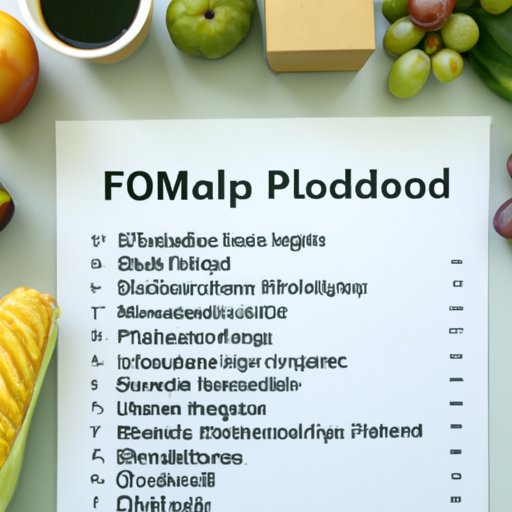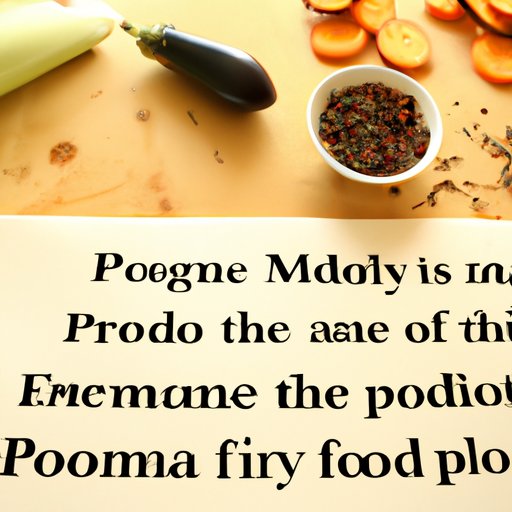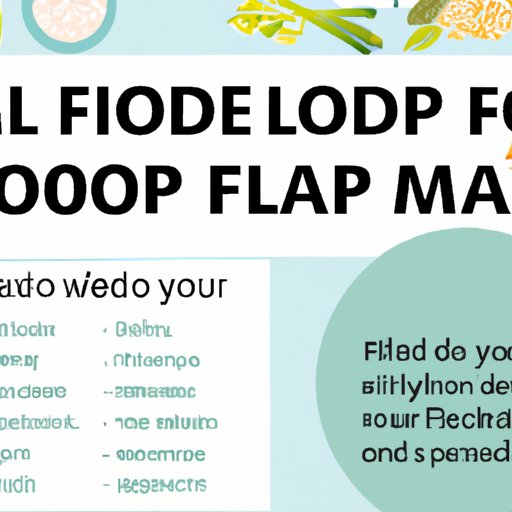Introduction
If you’ve been recently diagnosed with IBS or another digestive condition, you may have heard of the FODMAP diet. This diet is designed to help reduce abdominal pain and other symptoms associated with irritable bowel syndrome (IBS) and other digestive issues. But what exactly is a FODMAP diet? And what can you eat on it? In this article, we’ll explore the benefits of eating a FODMAP diet, provide recipes and meal ideas, and offer tips and tricks for sticking to a FODMAP diet. We’ll also interview an expert for advice on the FODMAP diet.

Overview of What is Allowed on a FODMAP Diet
A FODMAP diet eliminates certain types of carbohydrates that are not completely absorbed in the small intestine. These carbohydrates are known as fermentable oligo-, di-, mono-saccharides and polyols, or FODMAPs for short. Common FODMAPs include lactose, fructose, fructans, galactans, and polyols. Foods that are high in FODMAPs include dairy products, wheat, onions, garlic, apples, peaches, and certain types of beans. By reducing foods that contain these FODMAPs, individuals can often reduce their symptoms of IBS and other digestive conditions.

Exploring the Benefits of Eating a FODMAP Diet
A FODMAP diet has been shown to be beneficial for individuals with IBS and other digestive conditions. According to a study published in The American Journal of Gastroenterology, “adherence to a low-FODMAP diet is associated with significant improvements in gastrointestinal symptoms in patients with IBS.” The study found that following a FODMAP diet led to improvement in abdominal pain, bloating, and flatulence, and that the effects were maintained over time. Additionally, a review published in Gut found that a low-FODMAP diet was effective in reducing symptoms of IBS and improving quality of life.
Recipes and Ideas for Delicious FODMAP-Friendly Meals
Breakfast Options
Start your day off right with a delicious breakfast that follows the FODMAP diet. Try scrambled eggs with spinach, tomatoes, and mushrooms cooked in olive oil. You can also make a smoothie with almond milk, frozen blueberries, banana, chia seeds, and ground flaxseed. For a sweet treat, try gluten-free oatmeal pancakes topped with fresh fruit. If you’re looking for something quick and easy, try a bowl of gluten-free cereal with almond milk and sliced banana.
Lunch Ideas
For lunch, try a quinoa salad made with diced cucumber, olives, feta cheese, and lemon juice. You can also make a wrap with grilled chicken, lettuce, tomato, and avocado. For a vegetarian option, try a veggie burger with lettuce, tomato, onion, and avocado on a gluten-free bun. Or make a soup with chicken broth, carrots, celery, and shredded chicken. Top it off with some freshly chopped parsley.
Dinner Dishes
For dinner, try roasted salmon with steamed vegetables. Or make a stir-fry with tofu, bell peppers, onions, and snow peas cooked in sesame oil. You can also make a vegetarian chili with black beans, corn, tomatoes, and bell peppers. If you’re feeling adventurous, try making a risotto with arborio rice, mushrooms, and asparagus. Top it off with freshly grated Parmesan cheese.
Snacks and Desserts
Snacking can be tricky when following a FODMAP diet, but there are plenty of options. Try a handful of almonds or pistachios, or a piece of gluten-free toast with almond butter. For a sweet treat, try a slice of gluten-free banana bread or a homemade granola bar. You can also make a trail mix with nuts, dried fruit, and dark chocolate chips. And for a refreshing drink, try a glass of coconut water or a cup of herbal tea.
Tips and Tricks for Sticking to a FODMAP Diet
Grocery Shopping Strategies
Grocery shopping can be overwhelming when first starting a FODMAP diet. To make things easier, create a grocery list before heading to the store. Focus on buying fresh fruits and vegetables, lean proteins, and gluten-free grains and starches. Avoid processed and packaged foods, as they often contain hidden sources of FODMAPs. Also, read labels carefully to look for added sugars and other ingredients that may contain FODMAPs.
Meal Planning Tips
Meal planning is key to sticking to a FODMAP diet. Make a plan for the week ahead and shop for all the ingredients you need. If you’re pressed for time, double up on recipes so you can make two meals at once. You can also use leftovers to make new meals, such as adding leftover chicken to a salad or making a frittata with leftover vegetables. Having a plan will help you stay on track with your FODMAP diet.
Eating Out Tips
Eating out can be challenging when following a FODMAP diet. Look for restaurants that offer gluten-free and low-FODMAP options, such as sushi restaurants or Mexican restaurants. When ordering, ask questions about ingredients and preparation methods. Avoid dishes that contain dairy, wheat, onions, garlic, and other high-FODMAP foods. You can also ask the chef to prepare your meal without added FODMAPs, such as swapping out onions for bell peppers.

An Interview with an Expert on the FODMAP Diet
We had the chance to speak with Dr. Sarah Ballantyne, author of The Paleo Approach, about the FODMAP diet. Here’s what she had to say:
Background Information on the Expert
Dr. Sarah Ballantyne is a New York Times bestselling author and a leader in the field of evolutionary medicine. She holds a PhD in Medical Biophysics and is the founder of The Paleo Mom website. She is passionate about helping people lead healthier lives and is an advocate for the FODMAP diet.
Expert’s Advice on the FODMAP Diet
“The FODMAP diet is a great way to manage IBS symptoms,” says Dr. Ballantyne. “It can be a bit tricky to get started, but with some practice and patience, it can really help to reduce symptoms and improve quality of life.” She recommends keeping a food journal to help keep track of which foods trigger symptoms, as well as staying hydrated and getting enough sleep. Additionally, she suggests focusing on whole foods, such as fresh fruits and vegetables, lean proteins, and gluten-free grains and starches.
Common Questions Answered by the Expert
Q: Are there any supplements that can help with a FODMAP diet?
A: “Yes, there are several supplements that can be helpful,” Dr. Ballantyne says. “Probiotics can help to balance the gut bacteria, while digestive enzymes can help to break down FODMAPs. Additionally, magnesium and peppermint oil can help to reduce abdominal pain and bloating.”
Conclusion
The FODMAP diet is a great way to help reduce symptoms of IBS and other digestive conditions. By eliminating certain FODMAP-containing foods, individuals can often experience a reduction in abdominal pain, bloating, and flatulence. To make sticking to a FODMAP diet easier, try incorporating delicious recipes and meal ideas, as well as tips and tricks for grocery shopping, meal planning, and eating out. For more information, talk to your doctor or consult an expert on the FODMAP diet.
(Note: Is this article not meeting your expectations? Do you have knowledge or insights to share? Unlock new opportunities and expand your reach by joining our authors team. Click Registration to join us and share your expertise with our readers.)
